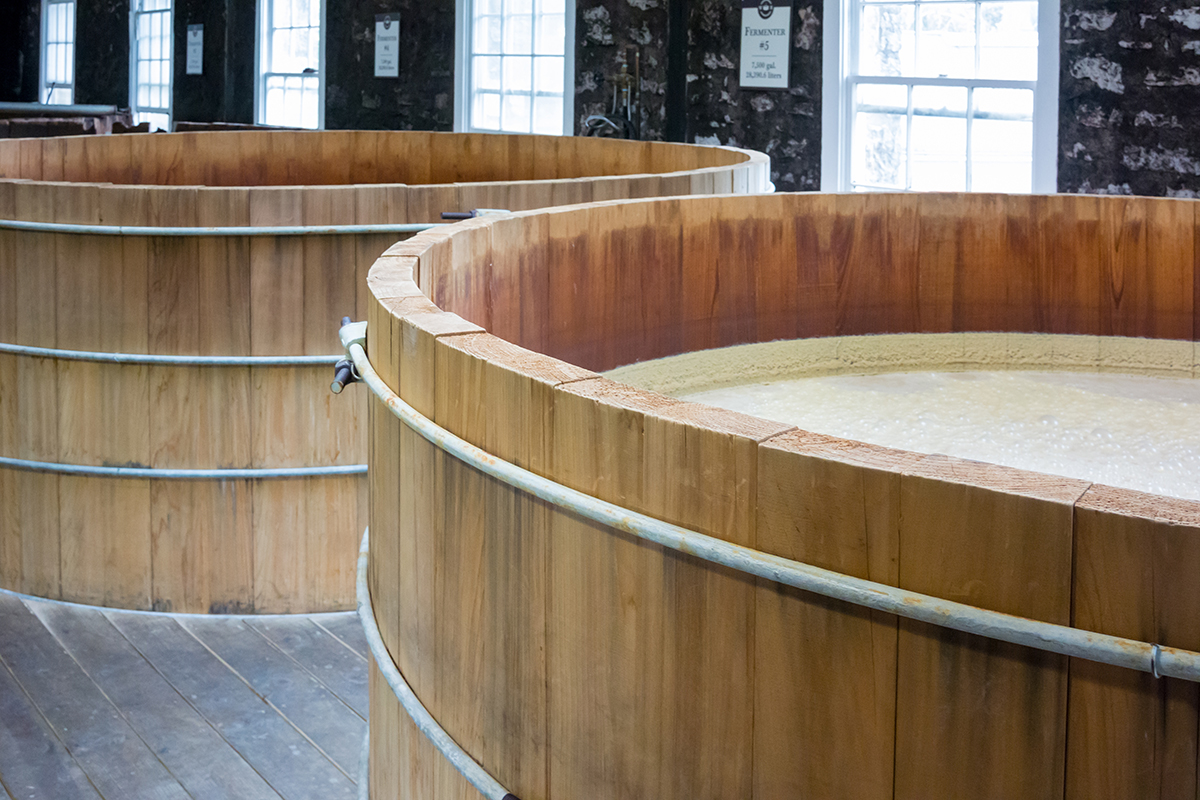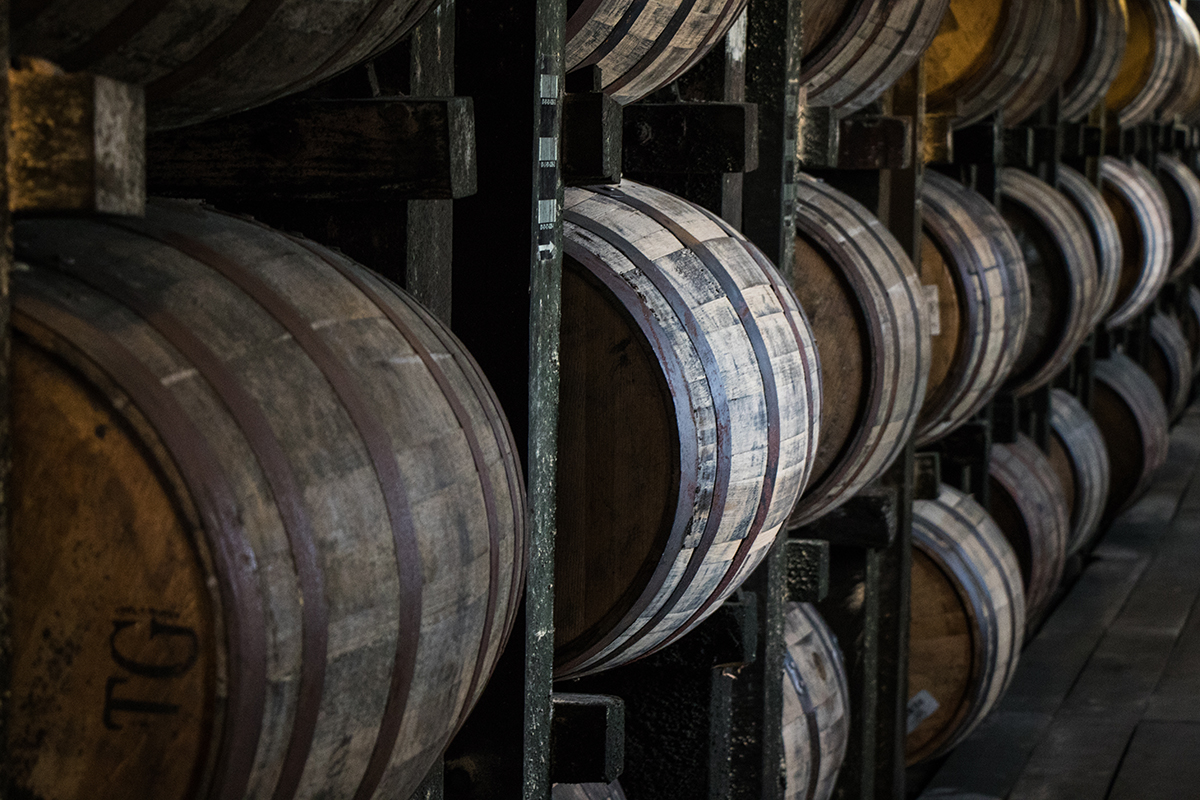How much importance can a single word have on your bottle of whiskey? Quite a lot, actually. That’s the case when it comes to the application of the word “straight” when found on the label of an American whiskey. Most people tend to think of it as a good indicator of potential quality — and it is, or at least it sets a floor in terms of certain minimum qualifications. But it’s worth knowing what it’s actually saying.
Straight Whiskey Defined
The Alcohol and Tobacco Tax Trade Bureau, or TTB, builds out all of its specifications from a starting definition of whiskey. First it indicates that whiskey must be distilled from fermented grain to no more than 95% ABV. Additionally, it must taste and seem like the thing we think of as whiskey, and it must be stored in oak (except corn whiskey). And it must be bottled with a minimum of 40% ABV.
 Fermentation barrels
Fermentation barrels
Straight whiskey then is a subcategory under that broad definition, indicating that a whiskey must be aged in new, charred oak for two or more years. Every type of legally defined American whiskey can then be further classified as straight. This includes bourbon, rye, wheat, malt and others.
For example, straight bourbon whiskey both meets the production requirements of bourbon and is also matured for the minimum required duration. This means that in addition to being aged for two years, straight bourbon whiskey must also: be distilled to no more than 80% ABV; include at least 51% corn; and be barreled at no more than 62.5% in new, charred oak.
And that’s usually how you’ll see the term, “straight bourbon whiskey,” or “straight rye whiskey.” When you see only “straight whiskey,” it’s for a product that isn’t made from at least 51% of a single grain, and therefore doesn’t qualify as a bourbon, a rye, a wheat or anything else.
Can Straight Whiskey Be Blended?
You better believe it. And this is where the definitions of American whiskey gets murky, because the word “blending” is used in so many ways. American blended whiskey on its own is a product which includes only a minimum of 20% straight whiskey. This allows the rest to potentially be neutral spirits. That obviously wouldn’t comply with being a straight whiskey, or bourbon or rye, for that matter.
 Whiskey barrels
Whiskey barrels
However, by definition, a straight whiskey can be a mixture of two or more straight whiskeys made within the same state. It doesn’t need to call itself a blend to do so, it’s simply allowed to do so. For example, a “Kentucky straight bourbon whiskey,” need not be produced in one place or even consist of a singular mash bill. It can include two or more straight bourbons made in Kentucky without any further label requirements.
If you want to include products made in different states, then you need to add the blended designation. Therefore, just as there’s a whole list of definitions for straight bourbon, straight rye and on down the line, there’s an equally lengthy list of blended, straight whiskeys, that allows for two or more straight whiskeys of a particular variety, made in different states, to be mixed together. In this way, you can have a blend of straight rye whiskeys, also known as “blended straight rye whiskeys,” which would be two or more straight ryes, made in different states, and blended together.
Origins
According to bourbon historian Michael Veach, the original legal definition for straight whiskey in the United States came under President William Howard Taft in 1909. This built upon earlier efforts via the 1906 Pure Food and Drug Act, and the Bottled-in-Bond Act of 1897, which remains famous in the whiskey world to this day. Several additions were made to the definition, such as the 1938 ruling that bourbon must be aged in new, charred barrels, with the standards for straight whiskey adjusted in turn.
No Additives
So all of the hubbub about straight whiskey is that it must be aged for two years in new, charred oak barrels? Not so fast.
Straight whiskey cannot include any additives in terms of flavor or caramel coloring. This is really the big sticking point that matters more than the time spent in a barrel.
After maturation, the only maneuverings you’re allowed to make with a barrel of straight whiskey are: batching it with other barrels of straight whiskey; particulate and/or chill-filtering; and bringing it down to proof using water. All of these steps are of course optional. As an example, a non-chill-filtered, cask strength single barrel straight whiskey wouldn’t go through any of them.
However, other whiskeys without the “straight” designation are legally allowed to include up to 2.5% additives. That includes bourbons, ryes and other types of American whiskeys. There’s some further nitty-gritty to explore with what is allowed in those instances, with the TTB specifying:
“Harmless coloring, flavoring, or blending materials that are not an essential component part of the particular distilled spirits to which added, but which are ‘customarily employed therein in accordance with established trade usage’ may be used in certain distilled spirits products, without changing the class or type of such spirits, if the materials do not total more than 2½ percent by volume of the finished product.”
Exceptions to the Rule
There’s even an acronym for “harmless coloring, flavoring, or blending materials” — HCFBM. Hopefully it’s not an acronym you’re coming across too often though, and it’s worth noting that what does or does not qualify is made on a case-by-case basis.
Suffice to say, for now, that if an American whiskey is over two years of age and was matured in new, charred oak (again, corn whiskey is an exception) and is not labeled as “straight,” it contains some form of additives. There’s no other reason to avoid the term or to be disqualified from it.
Want one more head-scratching exception? The category of “blended straight whiskeys” technically allows for HCFBM to be thrown back in! The TTB defines the category as a mixture of straight whiskeys produced in different states or as a mixture of straight whiskeys from the same state with those pesky HFCBMs. That exception essentially ends up undoing all of the hard definitions we just strove to define. But, ha ha, nobody would take advantage of that loophole, right?
Straight whiskey, in most cases, refers to an additive-free American whiskey aged for two or more years in new, charred oak. As we’ve seen though, there’s an exception to every rule, and a rule for every exception.
Ready to try some straight whiskey yourself?
With Distiller, you’ll always know what’s in the bottle before you spend a cent. Rate, Review, and Discover spirits. Head on over to Distiller, or download the app for iOS and Android today!
Want to enjoy Distiller ad-free? Join Distiller Pro today to support the Distiller platform and keep ads off of your screen.


